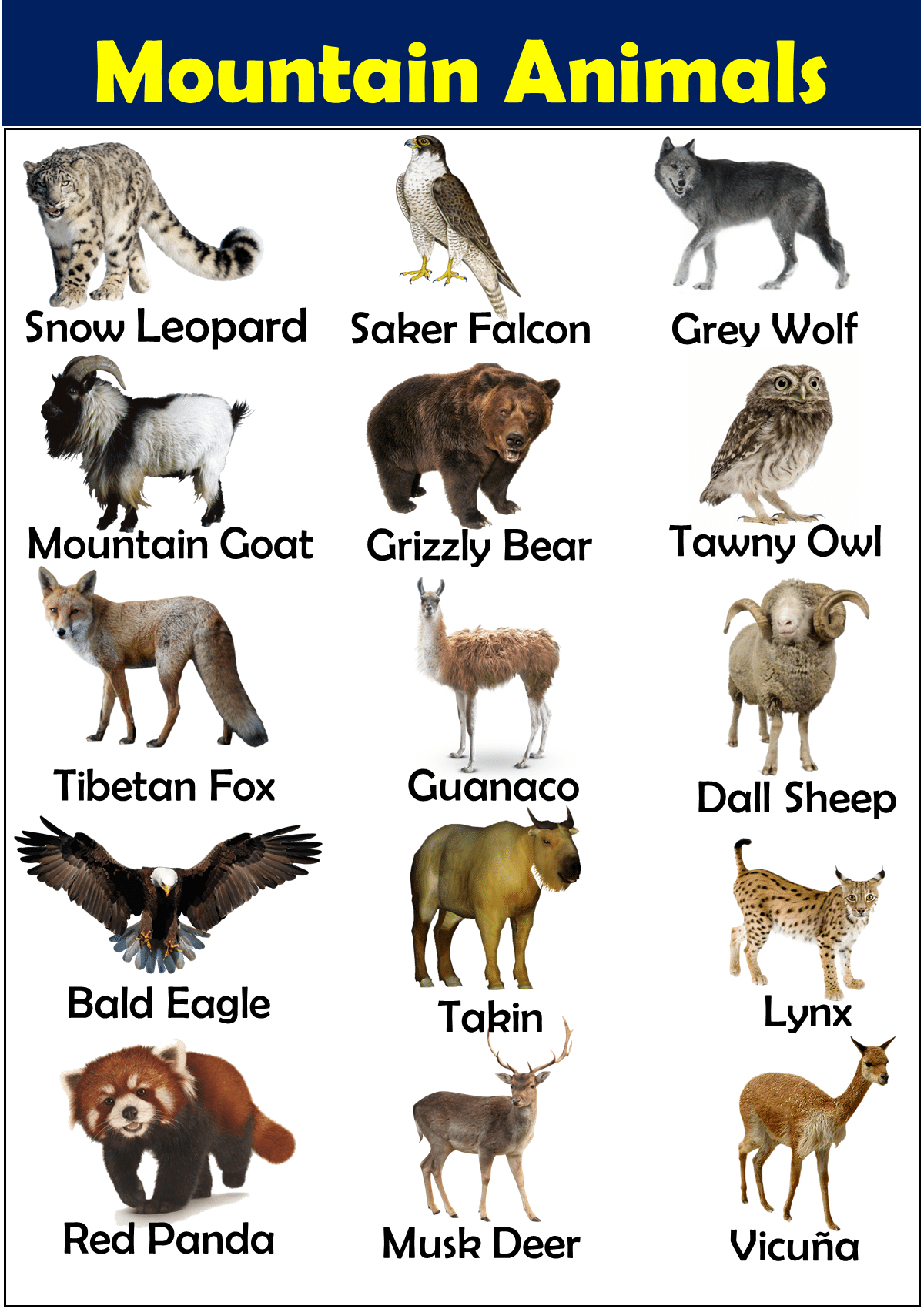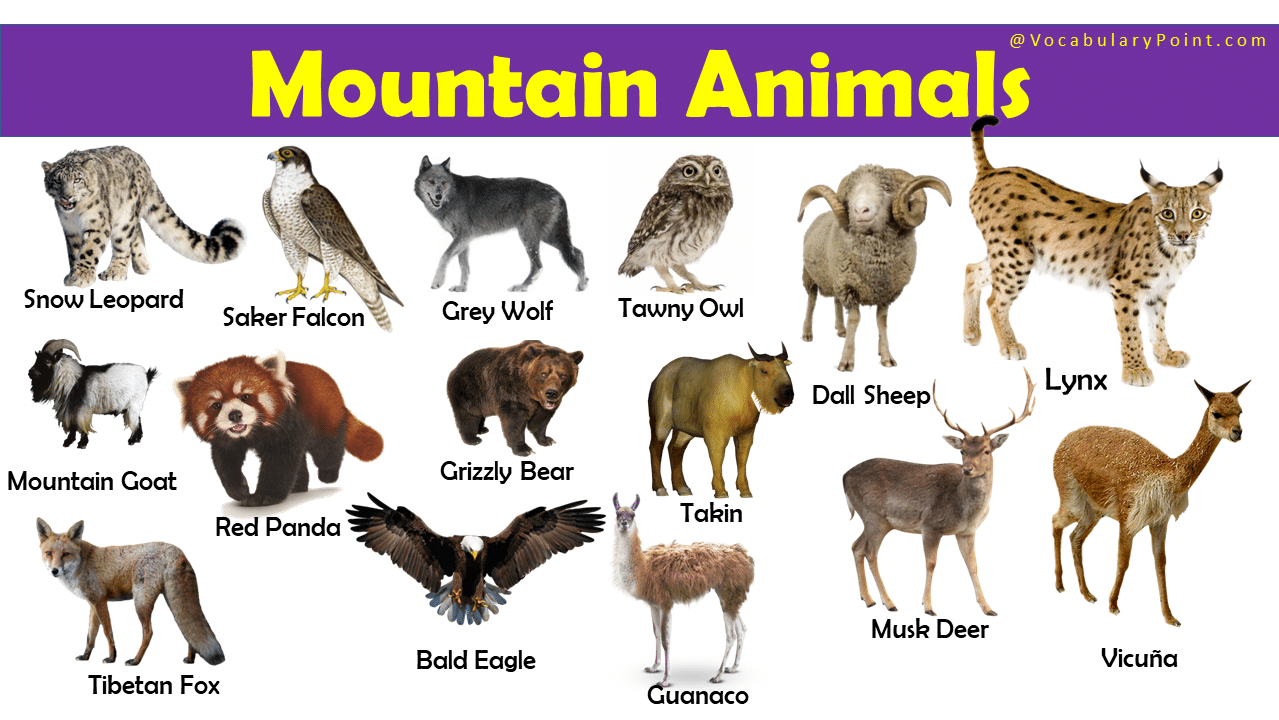Mountains are not just tall and majestic; they are also home to some incredible animals that have adapted to live high up where the air is thin and the temperatures are often cold. In this blog post, we will explore various mountain animals from all around the world. You will learn about their unique features, what they eat, and how they survive in such challenging environments. This will help you build your English vocabulary with some fascinating and advanced animal words. Let’s climb up the vocabulary mountain and meet these amazing animals!
What are Mountain Animals?
Mountain animals are species that are adapted to live in the mountainous regions of the world. Harsh conditions, including low temperatures, thin air, and rugged terrain often characterize these environments. Animals that thrive in such areas have developed unique adaptations that enable them to survive and thrive at high altitudes.
List of Mountain Animals
- Snow Leopard
- Mountain Goat
- Andean Condor
- Tibetan Fox
- Alpine Ibex
- Himalayan Tahr
- Vicuña
- Mountain Zebra
- Puma (Cougar)
- Marco Polo Sheep
- Llama
- Bald Eagle
- Grizzly Bear
- Siberian Ibex
- Chamois
- American Pika
- Musk Deer
- Himalayan Monal
- Argali Sheep
- Kea (Parrot)
- Lynx
- Rocky Mountain Elk
- Wolverine
- Red Fox
- Snowshoe Hare
- Mountain Pygmy Possum
- Yellow-throated Marten
- Golden Eagle
- Mountain Tapir
- Nubian Ibex
- Dall Sheep
- Alpine Marmot
- Giant Panda
- Bighorn Sheep
- Red Panda
- Himalayan Blue Sheep
- White-tailed Ptarmigan
- Tawny Owl
- Saker Falcon
- Black Bear
- Steller’s Sea Eagle
- Hoary Marmot
- European Lynx
- Alpine Chough
- Takin
- Himalayan Griffon
- Himalayan Goral
- Snow Partridge
- White-winged Woodpecker
- White-bellied Heron
- Siberian Musk Deer
- Carpathian Chamois
- Corsican Red Deer
- Patagonian Puma
- Guanaco
- Spectacled Bear
- Wallcreeper
- Ladakh Pika
- Siberian Chipmunk
- Grey Wolf
- North American Cougar
- Eurasian Lynx
- Andean Fox
- North American Porcupine
- Collared Peccary
- Bearded Vulture
- Mountain Weasel
- Long-tailed Tit
- Japanese Serow
- Asian Black Bear
Explore More Animal Vocab:

Mountain Animals Vocabulary and Their Facts
1. Snow Leopard
The snow leopard is a majestic creature found in the mountain ranges of Central and South Asia. Well-adapted to the cold, its thick fur and powerful build enable it to navigate the rocky alpine terrain. Snow leopards are elusive, primarily hunting at dawn and dusk, and are known for their remarkable ability to blend into the snowy landscape.
2. Mountain Gorilla
Mountain gorillas reside in the forested slopes of the Virunga Mountains in Central Africa. These critically endangered primates are larger and have thicker fur compared to their lowland cousins, adaptations to the colder climates. They live in groups and have a complex social structure led by a silverback.
3. Andean Condor
The Andean condor is one of the largest flying birds, with a wingspan up to 3.3 meters. Native to the South American Andes, this scavenger has a black plumage with a distinctive white collar and spends much of its time soaring on thermals, searching for carrion.
4. Alpine Ibex
Native to the European Alps, the Alpine ibex is a species of wild goat known for its impressive, backward-curving horns. These animals are excellent climbers, often seen scaling steep, rocky terrains. Their diet primarily consists of grasses, mosses, and lichens.
5. Himalayan Tahr
Originally from the Himalayas, the Himalayan tahr is a rugged, hoofed mammal which resembles a cross between a goat and an antelope. Adapted to life on steep slopes, it has a dense, woolly coat that protects it from the harsh mountain climate.
6. Llama
Llamas are domesticated South American camelids, widely used as meat and pack animals by Andean cultures since the pre-Columbian era. They are well-suited to harsh environments and capable of carrying 25% to 30% of their body weight over mountainous terrain.
7. Marco Polo Sheep
This species of argali sheep, named after the explorer Marco Polo, is found in the mountain ranges of Central Asia. They have the longest horns of any sheep, curling in a tight spiral, which they use for defense and dominance fights.
8. American Pika
The American pika is a small, mountain-dwelling mammal found in the rocky areas of the western United States. With a round body and short limbs, it is well adapted to cold climates, collecting and storing dried grasses for winter food.
9. Tibetan Fox
The Tibetan fox, found in the high steppes of the Tibetan Plateau, is easily recognizable by its square, flat-faced appearance. It primarily feeds on rodents, often following brown bears to scavenge leftovers.
10. Mountain Pygmy Possum
Native to the alpine and sub-alpine regions of southeastern Australia, the mountain pygmy possum is the only marsupial that hibernates. This small creature faces threats from climate change, which affects snow cover, a crucial element of its winter habitat.
11. Nubian Ibex
The Nubian ibex is a desert-dwelling goat species found in mountainous areas of the Middle East and Africa. Known for its long, curved horns and sure-footedness, it can climb steep, rocky terrains with ease.
12. Wolverine
Wolverines are robust and muscular carnivores, often associated with northern boreal forests and Arctic tundra, but also found in mountainous regions. They have a reputation for their strength and tenacity, able to take down prey much larger than themselves.
13. Golden Eagle
The golden eagle is a large bird of prey that inhabits mountains from North America to Eurasia. With a wingspan of up to 2.3 meters, it has remarkable hunting skills, preying on mammals and birds with deadly efficiency.
14. Vicuña
The vicuña is one of the smallest members of the camel family, living in the Andean highlands. Its wool is highly prized, finer and softer than any other wool in the world, and is key to its survival in the cold mountainous climate.
15. Alpine Marmot
The Alpine marmot is a large ground squirrel found throughout the European Alps. Known for its social behavior, it hibernates for up to nine months of the year to survive the winter. In the summer, it feeds voraciously to build fat reserves.
16. Takin
The takin, also known as the gnu goat, is a sturdy hoofed mammal native to the rocky, mountainous regions of the Himalayas. The takin has a thick, oily coat to keep it dry and warm in misty habitats, contributing to its mythical status in local cultures.
17. Red Panda
Native to the Eastern Himalayas and southwestern China, the red panda is slightly larger than a domestic cat. Its striking red fur and bushy tail provide camouflage in the mountainous forest canopy. The red panda is primarily herbivorous, eating mostly bamboo, but it can also hunt small prey.
18. Ethopian Wolf
The Ethiopian wolf is Africa’s most endangered carnivore and the world’s rarest canid. Found in isolated mountain ranges of Ethiopia, it preys predominantly on rodents. Its slender body and long legs are adaptations to its montane habitat.
19. Bald Eagle
Native to North America, the bald eagle is found near large bodies of open water with abundant food supplies and old-growth trees for nesting. In mountainous areas, they are often seen soaring high on thermal updrafts.
20. Kea
The kea is a large species of parrot found in the forested and alpine regions of the South Island of New Zealand. Known for its intelligence and curiosity, the kea is the world’s only alpine parrot, surviving in harsh mountainous conditions.
21. Greater Bamboo Lemur
Native to southeastern Madagascar, the greater bamboo lemur is critically endangered, primarily due to habitat loss and hunting. It lives in the rainforests, including those at higher elevations, and has a specialized diet consisting almost entirely of bamboo.
22. Bighorn Sheep
Bighorn sheep are native to North America and dwell in the rocky, mountainous terrains where they display incredible agility. Males are known for their large, curled horns, used in ritual ramming contests to establish dominance.
23. Spectacled Bear
The spectacled bear is the only bear species native to South America, primarily found in the Andes Mountains. It is named for the distinctive rings of white or light fur around its eyes, resembling spectacles.
24. Mountain Reedbuck
The mountain reedbuck is a medium-sized antelope found in mountainous areas of sub-Saharan Africa. It has a grey coat and a white underbelly, with males sporting forward-curving horns. They are mainly active at dawn and dusk, feeding on grasses.
25. Goral
The goral is a small, stocky hoofed mammal found in the mountains of Northeast India and Southeast Asia. It has a rough coat and a short, bushy tail, and is adept at navigating the steep and rocky terrain.
26. Grey Wolf
The grey wolf is a versatile predator that inhabits a wide range of habitats, including mountains across the Northern Hemisphere. These social animals hunt in packs, primarily preying on large ungulates.
27. Saker Falcon
The saker falcon is a large species of falcon that inhabits open grasslands, desert areas, and mountain ranges across Eurasia. It is a raptor with formidable hunting skills, often used in falconry.
28. Mountain Lion
Also known as the cougar or puma, the mountain lion has a broad range that includes mountainous regions of North and South America. This large, solitary cat is adept at climbing and can leap significant distances.
29. Wild Yak
The wild yak is native to the Himalayan region of South Central Asia. This large bovid is adapted to high altitudes, with a thick coat to withstand the cold mountainous environment. It is mainly a grazer, feeding on grasses and herbs.
30. Musk Deer
Found in the mountain forests of South Asia, the musk deer is known for its musk gland, which is highly valued as a perfumery ingredient. Unlike true deer, it lacks antlers but has prominent tusk-like teeth which males use during mating season disputes.
